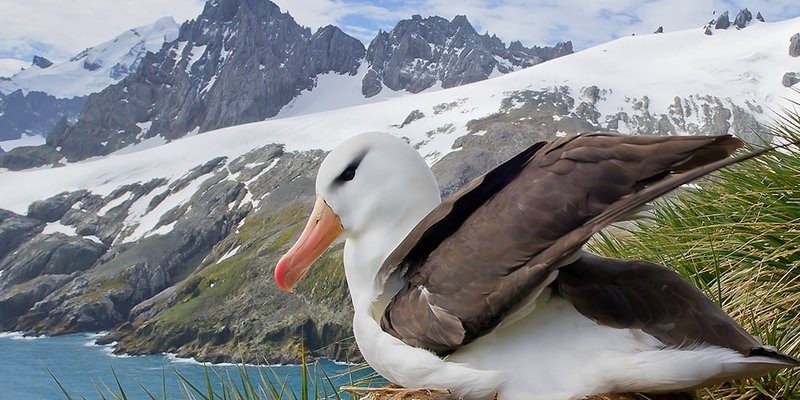
Imagine sitting by the shore, watching an albatross soar effortlessly above the waves. As you sip your coffee, you might wonder why this bird is often seen as a symbol of good luck or even a reminder of burdens. Let’s explore how the albatross has found its way into stories and beliefs across the globe. From sailors’ tales to poetry, its presence is profound, and its symbolism runs deep.
Albatross in Maritime Culture
The albatross has long been associated with sailors and the sea. For centuries, these birds have been spotted by mariners during long voyages across the ocean. You might be surprised to learn that many sailors viewed the albatross as a *good omen*. Some believed that seeing an albatross meant that good weather was ahead and that the journey would be safe.
However, there’s a darker side to this symbolism. The famous poem “The Rime of the Ancient Mariner” by Samuel Taylor Coleridge portrays the albatross as a harbinger of misfortune when it is killed by the mariner. This act brings a curse upon the ship, leading to dire consequences. Here, the albatross transforms from a symbol of luck to a metaphor for guilt and penance. It’s fascinating how one bird can represent two such contrasting ideas, isn’t it?
The Albatross as a Symbol of Burden
In literature, the phrase “albatross around one’s neck” has emerged, signifying a heavy burden or guilt that one carries. This phrase originates from Coleridge’s poem, where the mariner’s guilt over killing the bird weighs upon him. It’s a powerful image that resonates with many. Just as the mariner’s actions have led to suffering, we all have moments in life where we carry burdens—whether from poor choices, regrets, or responsibilities.
This duality of the albatross highlights how cultural representations can evolve. The bird, once seen as a sign of hope, takes on a more complex role. It shows us how perceptions can shift based on our actions and experiences.
Folklore and Myths Surrounding the Albatross
Across various cultures, the albatross has been woven into myths and folklore in intriguing ways. For instance, in some Indigenous cultures in the Pacific, the albatross is revered as a symbol of strength and endurance. These beliefs often stem from the bird’s ability to fly great distances without tiring.
In Hawaiian culture, the albatross, known as the *Kalae*, is considered a guardian bird. It’s believed that when an albatross appears, it carries messages from ancestors or the spiritual realm. This reverence showcases how the albatross is not just a bird but a significant figure in cultural identities and storytelling traditions.
The Albatross in Modern Folklore
Even in modern times, the albatross continues to inspire stories and artwork. You might find it in movies or music, often symbolizing a quest for freedom or the weight of past choices. For example, the bird’s majestic flight can be seen as a metaphor for breaking free from constraints and embracing one’s true self.
Artists and writers frequently use the albatross to convey themes of wanderlust and the idea of searching for one’s place in the world. It’s an apt representation of the human journey, reflecting our desire to explore while grappling with the consequences of our actions.
Environmental Symbolism of the Albatross
In recent years, the albatross has also become a strong symbol of environmental awareness. As these birds face threats from pollution, climate change, and fishing practices, their plight highlights the delicate balance of ocean ecosystems. Organizations use the image of the albatross to raise awareness about the impact of human actions on wildlife and encourage conservation efforts.
You might wonder how a bird can be symbolic in environmental conversations. The albatross represents not just the beauty of nature, but also the urgent need to protect it. Its struggle serves as a reminder that we all share responsibility for the health of our planet.
The Albatross in Conservation Stories
Many initiatives now use the albatross in storytelling to promote ocean conservation. For instance, educational programs often feature the bird to engage young audiences about the importance of keeping oceans clean and safe for marine life. By doing so, they connect the albatross’s majesty with the critical need for conservation, uniting aesthetics with action.
This approach also empowers individuals, showing how each of us can make a difference. Just like the albatross flying over vast oceans, our collective efforts can create ripples of change.
Artistic Representations of the Albatross
Art and literature often embrace the albatross in various forms. From paintings to poetry, artists have been inspired by its grace and symbolism for centuries. The albatross appears gracefully gliding through stormy skies or as a focal point in serene ocean landscapes.
In poetry, its representation often mirrors themes of longing and exploration. Poets might depict the albatross as a wanderer, restless and searching for meaning. This artistic choice resonates with many of us, reflecting our own quests for understanding in a vast world.
The Albatross in Music and Pop Culture
You might even find references to the albatross in songs and movies. In popular culture, it symbolizes freedom, adventure, and sometimes the emotional weight of one’s past. Numerous artists use the albatross as a metaphor for overcoming difficulties or yearning for liberation.
This incorporation into modern narratives shows the enduring influence of the albatross. Its symbolism remains relevant, bridging the gap between ancient stories and contemporary issues.
The albatross is much more than just a bird soaring across the ocean; it’s a complex symbol deeply ingrained in culture and folklore. Its journey from a lucky omen to a burden, and now to an environmental symbol, illustrates how our perceptions of nature can transform.
Whether serving as a reminder of the delicate balance in our ecosystems or offering personal reflections on freedom and responsibility, the albatross encourages us to reflect on our connection to the world around us. Next time you see one gliding effortlessly against the horizon, remember the rich tapestry of stories and meanings it holds. It’s this depth of symbolism that keeps the albatross relevant, allowing us to find both inspiration and lessons within its wings.

